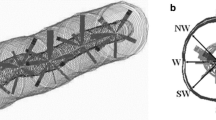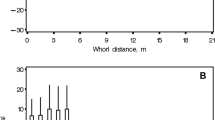Abstract
Recent research is underway to study cork oak (Quercus suber L.) wood potential for production of wood components. A total of 35 stems of young and mature cork oaks were sampled, live sawn into flitches, scanned using VTT’s WoodCIM®, and the measured data computed by VTT’s PuuPilot software, allowing stem 3D reconstruction. Sawing simulations were run for 0.5 m and 1 m logs and the whole stem. Sawn products were (1) planks, (2) parquet, (3) lamparquet, and (4) external component of multilayer planks. Cork oak stems showed a moderate to small taper (mean 24 mm/m). Curviness varied between straight to significantly crooked stems (mean value 40 mm) Batch yields for the tested products ranged 25–43% and 37–50% for 0.5 m logs of young and mature trees, respectively; for 1 m logs, batch yields ranged 19–41% and 25–54%. When using the whole stem, batch yields were lower, ranging 11–38% and 15–50%. Higher yields were obtained for all log lengths and samples for production of lamparquet, parquet, and multilayer component.





Similar content being viewed by others
References
Björklund L (1999) Identifying heartwood-rich stands or stems of Pinus sylvestris by using inventory data. Silva Fennica 33(2):119–129
Hallock H, Stern AR, Lewis DW (1978) Is there a “best” sawing method? Research Paper FPL-280. USDA Forest Service, Forest Products Laboratory, 11 pp
Ikonen V-P, Kellomäki S, Peltola H (2003) Linking tree stem properties of Scots pine (Pinus sylvestris L.) to sawn timber properties through simulated sawing. For Ecol Manag 174:251–263
Knapic S, Pereira H (2005) Within-tree variation of heartwood and ring width in Maritime pine (Pinus pinaster Ait.). For Ecol Manag 210:81–89
Knapic S, Louzada JL, Leal S, Pereira H (2007) Radial variation of wood density components and ring width in cork oak trees. Ann For Sci 64(2):211–218
Knapic S, Louzada JL, Leal S, Pereira H (2008) Within and between-tree variation of wood density components in cork oak trees in two sites in Portugal. Forestry 81:465–473
Leal S, Sousa VB, Pereira H (2006) Within and between-tree variation in the biometry of wood rays and fibres of cork oak (Quercus suber L.). Wood Sci Technol 40(7):585–597
Leban JM, Duchanois G (1990) SIMQUA: a simulation software for wood quality. Ann des Sci For 47:483–493
Maness TC, Lin Y (1995) The influence of sawkerf and target size reductions on sawmill revenue and volume recovery. For Prod J 45(11/12):43–50
Oja J (1997) Measuring knots and resin pockets in CT-images of Norway spruce. Division of Wood Technology, University of Technology, Luleå, Licenciate thesis, Skellefteå, p 6
Pereira H (2007) Cork: Biology, Production and Uses. Elsevier, Amsterdam
Pereira H, Tomé M (2004) Cork oak. In: Burley J (ed) Encyclopedia of forest sciences. Elsevier Ltd, Oxford, pp 613–620
Pinto I, Pereira H, Usenius A (2002) Sawing simulation of Pinus pinaster Ait. In: Nepveu G (ed) Proceedings of 4th workshop in “Connection between Silviculture and wood quality through modelling approaches and simulation softwares”. British Columbia, INRA, Nancy
Pinto I, Pereira H, Usenius A (2003) Analysis of log shape and internal knots in twenty maritime pine (Pinus pinaster Ait.) stems based on visual scanning and computer aided reconstruction. Ann For Sci 60:137–144
Pinto I, Pereira H, Usenius A (2004) Heartwood and sapwood development within Maritime pine (Pinus pinaster Ait.) stems. Trees 18(3):284–294
Pinto I, Usenius A, Song T, Pereira H (2005) Sawing simulation of maritime pine (Pinus pinaster Ait.) stems for production of heartwood containing components. For Prod J 55(4):88–96
Richards DB (1973) Hardwood lumber yield by various simulated sawing methods. For Prod J 23(10):50–58
Schmoldt D, Li P, Araman P (1996) Interactive simulation of hardwood log veneer slicing using CT images. For Prod J 46(4):41–47
Song T (1987) Optimization of sawing decision making through computer simulation. Laboratory of mechanical wood technology, Helsinki University of Technology, Licenciate thesis, Espoo, p 109
Song T (1998) Tree stem construction model for “Improved spruce timber utilisation” project. VTTs Building Technology internal report. Helsinki, p 20
Sousa VB, Leal S, Quilhó T, Pereira H (2009) Characterization of cork oak (Quercus suber L.) wood anatomy. IAWA Journal 30(2):149–161
Todoroki CL (1994) Effect of edging and docking methods on volume and grade recoveries in the simulated production of flitches. Ann des Sci For 51:241–248
Todoroki CL (1996) Developments of the sawing simulation software AUTOSAW—linking wood properties, sawing and lumber end-use. In: Nepveu G (ed) Proceedings of the 2nd Workshop on Connection Between Silviculture and Wood Quality through Modelling Approaches and Simulation Softwares, South Africa, INRA, Nancy, pp 241-247
Usenius A (1999) Wood conversion chain optimisation. In: Nepveu G (ed) Proceedings of 3rd workshop on connection between Silviculture and wood quality through modelling approaches and simulation softwares. La Londe-Les-Maures, INRA, Nancy, pp 542-548
Usenius A (2000) WoodCIM®—Integrated planning and optimizing system for sawmilling industry. VTTs Building Technology internal report, p 8
Acknowledgments
This study was partially funded by the European project Suberwood (QLRT 2000-0701) within the fifth Research Framework, and the Portuguese project SOBRO (AGRO 523) within the AGRO and FEDER Programmes. Centro de Estudos Florestais is a research unit funded by FCT (Portuguese Science Foundation) within the POCTI-FEDER Programme. The first authors acknowledge additional funding granted by FCT under the programme POCI—2010.
Author information
Authors and Affiliations
Corresponding author
Additional information
Communicated by T. Seifert.
An erratum to this article can be found at http://dx.doi.org/10.1007/s10342-011-0497-1
Rights and permissions
About this article
Cite this article
Knapic, S., Seppä, I.P., Usenius, A. et al. Stem modeling and simulation of conversion of cork oak stems for quality wood products. Eur J Forest Res 130, 745–751 (2011). https://doi.org/10.1007/s10342-010-0467-z
Received:
Revised:
Accepted:
Published:
Issue Date:
DOI: https://doi.org/10.1007/s10342-010-0467-z




